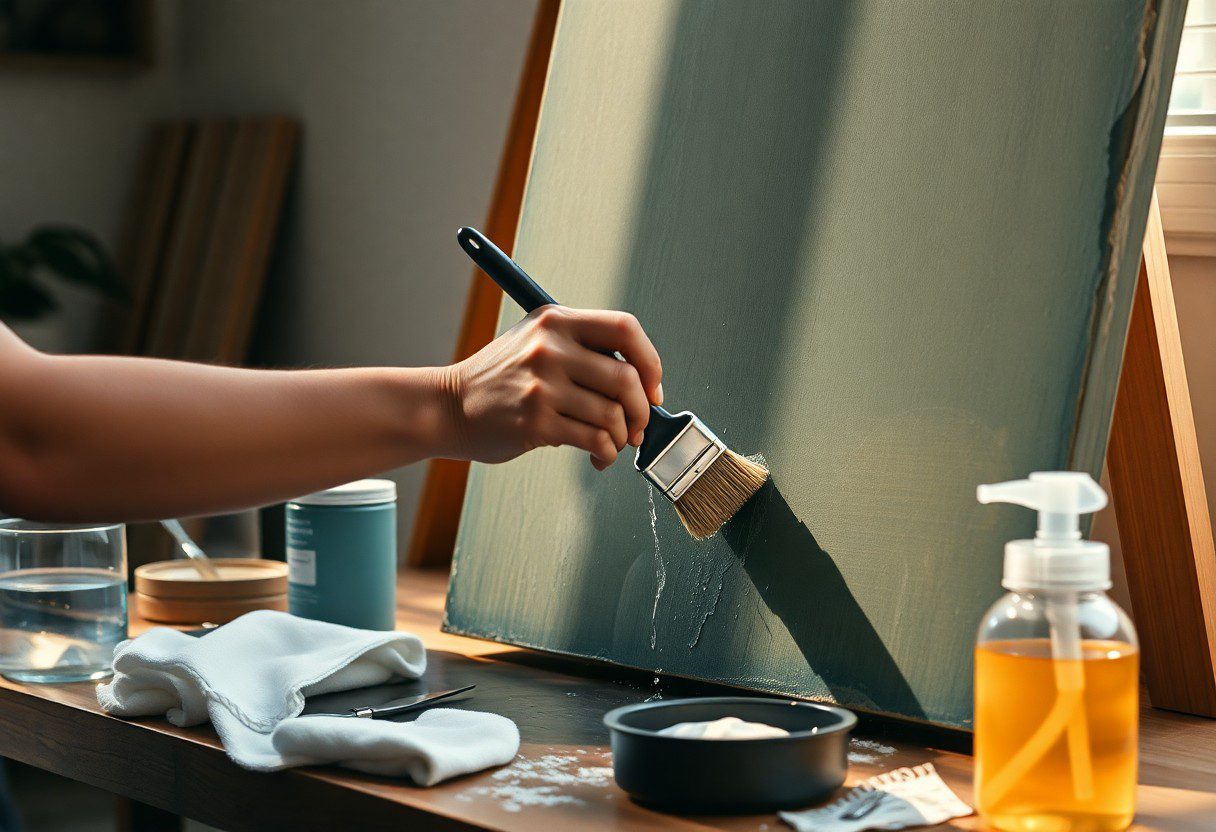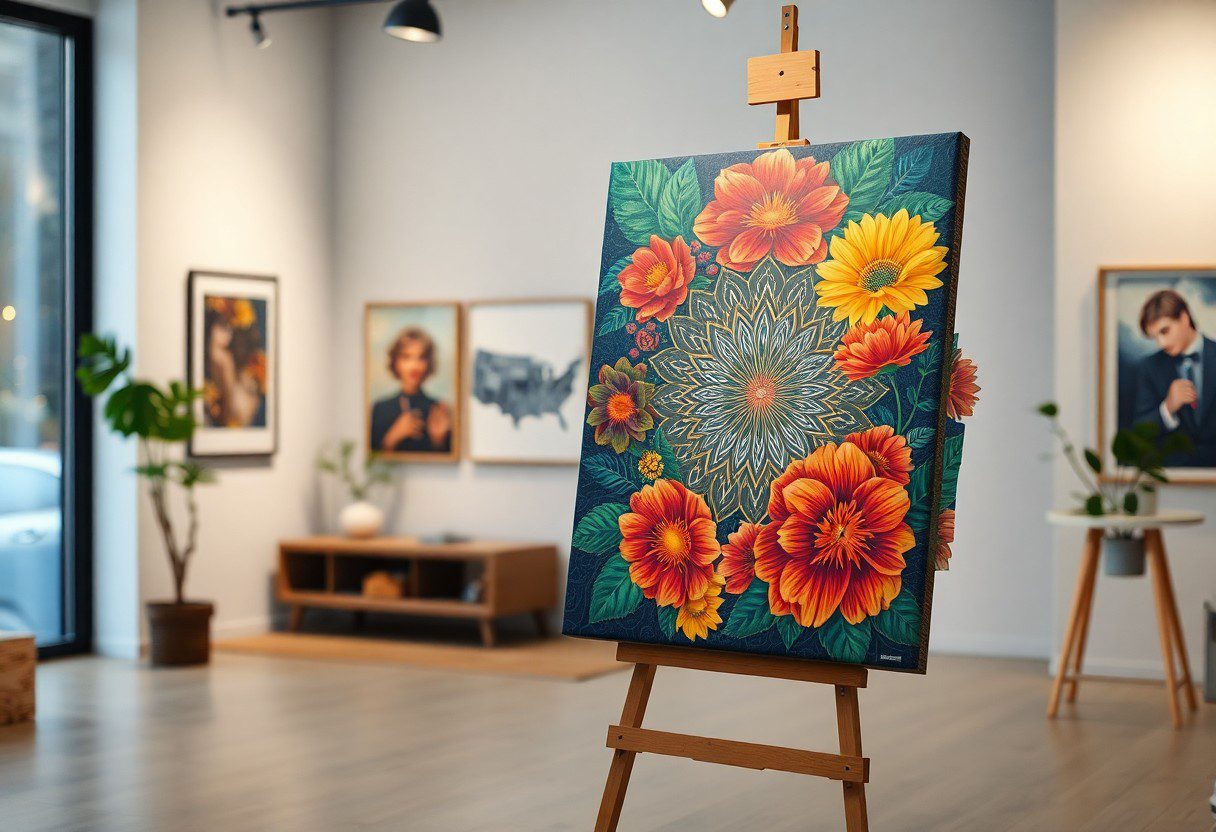There’s no limit to what you can do with your canvas when you unleash your creativity. By following a few simple techniques, you can transform a plain canvas into a stunning work of art that reflects your personal style. From choosing the right colors to applying various mediums, every decision can enhance the visual appeal of your canvas. In this guide, you’ll learn effective tips and tricks that will elevate your artistic expression and bring beauty to your blank canvas. Let’s get started on this exciting journey of creativity together!
Understanding Canvas Aesthetics
The beauty of your canvas lies in its aesthetics, which encompass the visual principles that enhance its overall appeal. This includes the arrangement of elements, use of colors, balance, and coherence that work together to create an eye-catching piece. Understanding these principles will help you elevate your artwork and achieve harmonious results that resonate with viewers.
Key Factors in Canvas Design
To craft an attractive canvas, consider the following key factors:
- Balance: Ensuring visual equilibrium in your composition.
- Contrast: Utilizing differences in color and size to draw attention.
- Focus: Creating a visual centerpiece within your design.
- Unity: Ensuring all elements work together seamlessly.
The combination of these factors transforms a simple canvas into a lovely artwork.
The Importance of Color Theory
Aesthetics play a significant role in how you perceive your canvas, and color theory is paramount to this experience. By understanding the psychological effects of colors, you can create an emotional connection with your audience. For example, using complementary colors can evoke harmony, while contrasting colors can create tension and excitement. Choose your color palette wisely to evoke the desired feelings and enhance the visual impact of your artwork.
Canvas design employs color theory to build a narrative and evoke particular emotions in your audience. Familiarizing yourself with color wheel principles, such as analogous and triadic schemes, allows you to enhance cohesiveness and harmony in your work. Each color can convey diverse meanings; warm tones may evoke energy or passion, while cool colors often provide a sense of calm and tranquility. By strategically integrating color into your composition, you can significantly impact how your canvas resonates with viewers, thus transforming an ordinary piece into an extraordinary visual experience.
Selecting the Right Materials
Assuming you want to enhance your artwork, choosing the right materials is crucial for achieving the aesthetic you desire. The type of canvas you select can greatly influence the overall look and texture of your piece. Always opt for high-quality materials that suit your preferred medium, whether it’s acrylics, oils, or mixed media. This will not only improve your painting experience but also the longevity and appearance of your artwork.
Canvas Types and Their Characteristics
Little did you know that different canvas types can change your artistic outcome. Here’s a quick breakdown:
| Canvas Type | Characteristics |
| Cotton Duck | Lightweight, inexpensive, versatile. |
| Linen | Durable, luxury feel, great texture. |
| Primed | Ready for painting, saves prep time. |
| Unprimed | Offers more absorbency, requires extra prep. |
| Canvas Board | Rigid backing, portable, easy to frame. |
This information will guide your decision-making process when selecting canvas types suitable for your artistic vision.
Tools and Supplies for Decorative Techniques
An assortment of tools and supplies can elevate your decorative techniques and overall aesthetic. Investing in quality brushes, sponges, and texture tools will enable you to apply various techniques effectively. Additionally, having access to stencils, palette knives, and moldable materials can enhance your creative exploration.
Characteristics of your tools and supplies are particularly important, as they affect the quality of your decorative applications. Soft brushes can create delicate strokes, while sturdier brushes enable bold textures. Safety gear is also vital; always use gloves and masks when working with chemical products to avoid adverse reactions. Choosing the right tools can lead to stunning, memorable artwork that genuinely captures your creative essence.
Techniques to Enhance Canvas Beauty
Some techniques can significantly elevate the aesthetic appeal of your canvas. Whether you want to create depth, texture, or striking visual elements, exploring various methods will help you transform a simple piece into a captivating work of art. By integrating different applications and materials, you can effortlessly enhance your canvas and ensure it stands out.
Painting Techniques
One effective way to enhance your canvas is through innovative painting techniques, such as layering, glazing, or using palette knives. Experimenting with different brush strokes and color combinations allows you to develop a unique style that reflects your artistic vision. Mixing mediums can also result in captivating effects, elevating the overall beauty of your piece.
Texturing Methods
Even more impactful are texturing methods that give your canvas a three-dimensional feel. You can create interesting visual effects by incorporating various materials, like gels, pastes, and even natural elements, into your artwork.
Plus, adding texture not only adds depth but can also draw the viewer’s eye. Consider using gel mediums to create raised surfaces or acrylic pastes for a more pronounced effect. Tools like sponges, brushes, or even your hands can help in manipulating these materials. Ensure you work with care, as the application process can sometimes be messy, but the rewarding results are worth the extra effort. Your textured canvas will invite touch and admiration, making your artwork truly come alive.
Incorporating Personal Touches
After you’ve established a basic design, incorporating personal touches can transform your canvas into a unique reflection of yourself. Consider adding meaningful quotes, memories, or symbols that resonate with you. This ensures that your art not only looks beautiful but also tells a story that is distinctly yours, making it a piece you’ll cherish for years to come.
Using Stencils and Patterns
On your journey to personalizing your canvas, stencils and patterns can provide a foundation that enhances your creative expression. They allow for precise shapes and designs while offering a variety of options that can suit various themes. By layering different stencils, you can create depth and interest in your artwork.
Adding Mixed Media Elements
Some artists find that incorporating mixed media elements elevates their canvas art to new heights. Combining materials such as fabrics, papers, and found objects allows you to explore texture and dimension in a way that traditional paint alone cannot achieve.
A layered approach using mixed media can bring energy and visual excitement to your canvas. You might experiment with mod podge to adhere fabrics or cut-out images, while layering different elements can create a sense of depth. Incorporating items like natural materials and photographs can add unexpected personal significance, intertwining elements of your life into your artwork. Just be mindful of balance; too many elements can overwhelm your design. Focus on harmony and how each material complements your overall vision.
Tips for Displaying Your Canvas
To effectively display your canvas, consider these imperative tips:
- Choose the right wall color to complement your canvas.
- Utilize proper lighting to highlight its details.
- Group smaller canvases to create an engaging gallery wall.
- Hang at eye level for optimal viewing.
Knowing these tips will help transform your space while emphasizing your canvas’s beauty.
Choosing the Right Framing Options
For a polished look, select framing options that enhance your canvas without overpowering it. Consider materials and colors that match your decor style, and opt for frames that provide the right depth and support for your artwork.
Optimal Display Locations
While selecting display locations for your canvas, think about the light and traffic patterns in your home. Avoid placing it in direct sunlight, which can cause fading, and steer clear of damp areas to prevent mold. Ideal spots include living rooms, hallways, and entryways where guests can appreciate your canvas.
Locations that showcase your canvas effectively involve high-traffic areas where the artwork can be appreciated without risk. Ensure your canvas is positioned away from heat sources and areas where it might encounter direct moisture. Consider placing the canvas in prominent living areas to create a visually appealing focal point. These thoughtful placements will enhance the experience of your art, bringing it to life in your everyday environment.
Troubleshooting Common Issues
Not every canvas project will go as planned; you may encounter issues such as paint bleeding, fading, or uneven textures. Assessing the problem early can save you time and materials. If you notice any flaws, take a moment to analyze them before proceeding. With a few adjustments and techniques, you can resolve these challenges and elevate your artwork to the next level.
Fixing Mistakes in Canvas Art
Fixing mistakes in your canvas art may seem daunting, but small errors can often be easily corrected. If you’ve made an unintended mark or color mishap, try using a fine brush to paint over the area with the right color. For larger issues, you can strategically incorporate elements of the mistake into your design, turning it into a unique feature instead.
Maintaining Canvas Vibrancy
Assuming you want your canvas art to last, you’ll need to focus on maintaining its vibrancy. Shield your artwork from excessive sunlight and humidity, which can lead to fading and discoloration over time. Regularly check for dust and clean carefully using a soft cloth to avoid damaging the surface.
A well-maintained canvas can retain its vivid colors and texture for years to come. To further protect your artwork, consider applying a high-quality varnish or protective spray, which helps seal in colors and shields against UV light. Even dust can affect the appearance, so routinely dusting your canvas ensures it looks its best. By taking these steps, you can enjoy your canvas art’s full vibrancy and beauty for the long haul.
Summing up
Drawing together all the tips and techniques discussed, you have the tools to transform your canvas into a visually appealing masterpiece. Start by choosing a harmonious color palette and incorporate various textures to add depth. Experiment with composition and balance to guide the viewer’s eye, while thoughtful layering can bring your artwork to life. Don’t forget to neglect the importance of finishing touches, like signatures and varnishes, to protect and enhance your piece. With creativity and practice, your canvas will shine beautifully.
FAQ
Q: What materials do I need to make my canvas look pretty?
A: To enhance the appearance of your canvas, gather materials such as acrylic paints, brushes of various sizes, paint markers, stencils, and texture tools. Additionally, consider using embellishments like glitter, beads, or fabric to add dimension and interest to your artwork.
Q: Can I use different painting techniques to beautify my canvas?
A: Absolutely! Different painting techniques can add unique touches to your canvas. Techniques such as blending, stippling, and layering can create depth, while splattering and pouring can add dynamic patterns. Experiment with these methods to discover what you like best.
Q: How can I incorporate textures into my canvas art?
A: You can create textures on your canvas using a variety of approaches. Try using palette knives to apply thick paint, adding modeling paste or gel mediums, or incorporating mixed media elements like fabric or paper. Each method can bring a different tactile quality to your work.
Q: What color schemes work best for a pretty canvas?
A: Color schemes greatly affect the overall aesthetic of your canvas. For a harmonious look, consider using analogous colors (next to each other on the color wheel) or complementary colors (opposite each other on the color wheel) for contrast. You can also select a monochromatic scheme by using varying shades of a single color for a sophisticated feel.
Q: How can I personalize my canvas art?
A: Personalization can be achieved by incorporating your interests or experiences into your canvas. Use symbols that represent something meaningful to you, incorporate phrases or quotes that resonate, or design elements inspired by your favorite colors or styles. This adds both character and a personal touch to your work.
Q: What should I do if I make a mistake while painting my canvas?
A: Mistakes can often lead to unexpected creativity! If you make a mistake, consider using it as an opportunity to enhance your design. You could integrate the mistake into the artwork with additional layers or paint over it to create a new element. Techniques like collage can also help you incorporate changes smoothly.
Q: How can I finish my canvas to ensure it looks polished?
A: To give your canvas a finished, polished look, consider applying a varnish or sealant once your paint is dry. This will protect your artwork and enhance the colors. Additionally, framing your canvas or adding a decorative border can elevate its presentation and make it more visually appealing.




